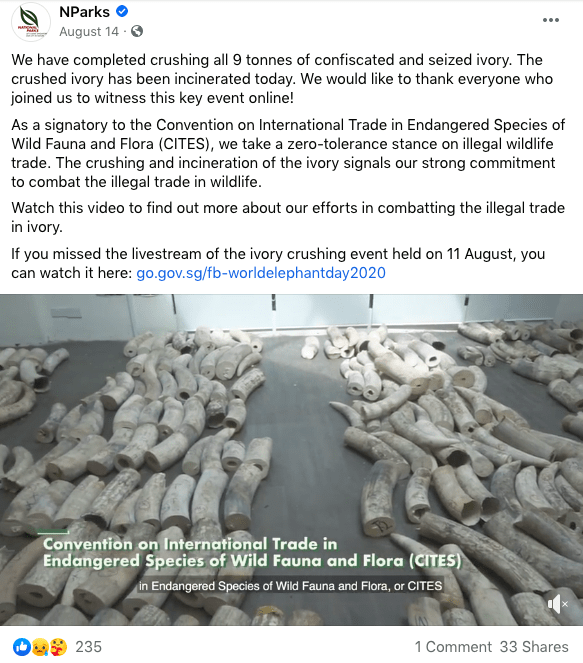In this digital age, I’m sure many of us have been on social media! In fact, it may even be a big part of our lives. I don’t think I can live without Instagram and/or Facebook anymore, do you guys feel the same? In my previous posts, I’ve always been reiterating how important spreading awareness of illegal wildlife trade is and online platforms such as social media and blogging are one of the best ways to send a message across! For example, in the case of Singapore, have you heard about the 9,000kg of ivory crushed on August 11th this year by NParks?
I found out about this on social media and through this, I felt like I understood more about the severity of the trade as well as our government’s stance and I hope many Singaporeans felt the same. Moreover, it really opened my eyes to that the illegal wildlife trade doesn’t just happen in other countries but right here at a large scale which to me is truly frightening. Thus, this is one of the reasons why I feel social media is such an important platform to raise awareness and combat the illegal wildlife trade! Furthermore, the spread of reliable information through social media could potentially debunk myths and change behaviors.

Screenshot of comments from the mothership post about ivory crushing
Posting news on social media, however, can also spark debates on what people think is good and bad. While everyone is entitled to their views, this can also spread to fake or unreliable news. For example, in this comment, many people are pushing for the ivory to be put back in the market to prevent wastage and increase in price which is a weak argument. If we were to introduce these ivories back into the market, it would not only increase supply and demand but send a message that Singapore is open to illegal wildlife trade, the opposite of what we should be doing! Furthermore, what would happen when the supply of cheap or fake ivory run out? The consequences could be direr as by then, it would be a more established product, making curbing the trade harder.
The spreading of fake news also reminds me of Sarah-Ann’s blog where she did a mini-experiment to see if people could tell the difference between a fake or a real photo! Spoiler alert – many couldn’t. This serves as a good reminder that while everything is pretty much available on the internet, we also ought to be careful of the things we read and to verify that it is from legitimate sources.
With this, we can see that social media can be a double-edged sword. On top of fake news, it can also both intentionally or unintentionally promote and serve as a vector for illegal wildlife trade, especially for exotic pets.

Source: URL
What do you feel when you see this picture of a slow loris? Does it make it seem so cute that you would want one? The illegal pet trade is actually one of the driving factors endangering this species and I believe social media has a role to play as well.
Furthermore, while a quick Facebook search didn’t give me any results for the sale of pets in Singapore, I did find people openly selling or asking for exotic pets as shown below! When I clicked on Muhammad Abubakar’s profile, I was shocked to actually see his display picture as him with a chained lion cub!
Hence, while social media can be an effective tool to spread awareness about the illegal wildlife trade, it is also important to note how it can promote it as well! Social media platforms can also use their unique positions now to disrupt the trade by content moderation and sharing information with their local authorities (URL).



October 25, 2020 at 4:55 pm
Hi Stacia, I’m glad that you enjoyed my blog post and I had a lot of fun conducting that experiment! I agree with you that social media can be a great way to help raise awareness on the illegal wildlife trade but I also believe that others can misuse this platform to perform wildlife trade transactions. How do you think authorities can crack down on wildlife trade activities online? Do you think that other stakeholders like ordinary social media users also have a part to play when it comes to stopping the illegal wildlife trade and how big a role do you think they have?
October 26, 2020 at 2:34 pm
Hi Sarah-Ann,
I believe that in order to curb illegal wildlife trade online, there is a need for good collaborative efforts between social media platforms and governments. Governments could also potentially have designated units such as cybercrime to tackle these online sales as well. As for our role, I believe that first of all is to not get involved and potentially increase the demand and incentivize more and more stakeholders to go online. Secondly, as sellers can also adapt to government interventions, there may be things that only we see that the government does not. Hence, we could also potentially be the eyes and ears of the government online, which is also crucial to help tackle and reduce the demand for online trade!